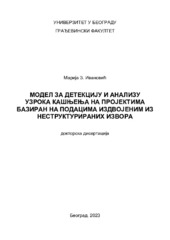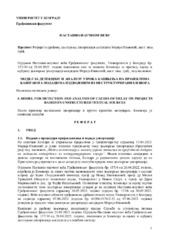Приказ основних података о дисертацији
Модел за детекцију и анализу узрока кашњења на пројектима базиран на подацима издвојеним из неструктурираних извора
ǂA ǂmodel for detection and analysis of causes of delay on projects based on unstructured textual sources
| dc.contributor.advisor | Stojadinović, Zoran | |
| dc.contributor.other | Ivanišević, Nenad | |
| dc.contributor.other | Trivunić, Milan | |
| dc.contributor.other | Marinković, Dejan | |
| dc.contributor.other | Nedeljković, Đorđe | |
| dc.creator | Ivanović, Marija | |
| dc.date.accessioned | 2023-12-13T11:44:19Z | |
| dc.date.available | 2023-12-13T11:44:19Z | |
| dc.date.issued | 2023-07-07 | |
| dc.identifier.uri | https://eteze.bg.ac.rs/application/showtheses?thesesId=9396 | |
| dc.identifier.uri | https://fedorabg.bg.ac.rs/fedora/get/o:31954/bdef:Content/download | |
| dc.identifier.uri | https://plus.cobiss.net/cobiss/sr/sr/bib/123419657 | |
| dc.identifier.uri | https://nardus.mpn.gov.rs/handle/123456789/21963 | |
| dc.description.abstract | ашњење, базни узроци кашњења, изградња путне инфраструктуре, машинско учење, рударење по текстуалним документима, Transformer, неструктурирани подаци | sr |
| dc.description.abstract | Time overrun in construction projects is a global phenomenon that has been researched for decades. The traditional approach to detection and analysis of causes of delay usually involves gathering experts’ experiences acquired on similar projects (grouped by their type or geographical location). The result of such an approach is list of causes of delay, hierarchically arranged according to their importance. Such empirical research is burdened with bias and subjectivism of experts and does not lead to the detection of the root causes of delay at a single project level. A database, formed using data collected from 75 road infrastructure projects implemented in Serbia between 2004 and 2021, is used to demonstrate the traditional approach’s weaknesses and to create a basis for establishing a new approach. The results of research and analysis of the database show that over 80% of projects got delayed with an average time overrun greater than 90% of the contract duration. Based on the survey involving key stakeholders on the database projects, a causes of delay list was formed that does not deviate from lists in most studies. Furthermore, low values of Spearman rank correlation were obtained (0,204 - 0,565) between attitudes of different stakeholders, which confirms the significant presence of subjectivism and bias in the conducted empirical research (surveys). The main goal of the doctoral dissertation is to create a new model for unbiased discovery of the root causes of delays at the single project level and its entities, using machine learning on unstructured text documentation from the project. The chosen documentation for the development of the model is Minutes of Meetings (MoM) because they contain comprehensive information about delays, which occurred at the time of the issues, with a precise time frame. Machine learning techniques using Transformer language models enable automatic detection of causes of delays. Focused expert knowledge is used for additional unbiased training of the model for the selected domain of road infrastructure, by connecting parts of the text with causes of delay from a previously defined list. Recognized entities of road infrastructure projects are tunnel, route, and bridge. By combining the mentioned elements, the dissertation developed an analytical Model for the detection and analysis of the causes of delays in road infrastructure construction projects, called DREAM (Delay Root-causes Extraction and Analysis Model). In the first phase, DREAM automatically generates a causes of delay list by project entities, based on the frequency of their occurrence in Minute of Meetings. The results show that the model can detect the causes of delay, returning acceptable recall values (recall = 0.69, for the most frequent causes of delay). In the second phase, enabled by MoM dates, DREAM adds a new and unique feature – graphs of the temporal distribution of causes of delay during the project. x By qualitatively analyzing these graphs that show the frequency and intensity of individual causes of delay, experts can understand the nature of the causes of delay, which enables them to detect root causes, the ultimate goal of all research related to delays on construction projects. The conducted research provides scientific and practical contribution. A new approach to the causes of delays identification and analysis is proposed through a developed analytical model based on unstructured data, machine learning, and the focused use of expert knowledge. DREAM overcomes the disadvantages of the traditional approach when creating a causes of delay list, and enables the discovering of the root causes of delay by applying a unique feature - temporal distribution of the causes of delay. In a practical sense, the proposed model provides unbiased support in reconstructing the events related to delay at the single project level and its entities, which contributes to the reduction of disputes between contracting parties and aide intelligent decision-making on future projects. | en |
| dc.format | application/pdf | |
| dc.language | sr | |
| dc.publisher | Универзитет у Београду, Грађевински факултет | sr |
| dc.rights | openAccess | en |
| dc.rights.uri | https://creativecommons.org/licenses/by-nc-nd/4.0/ | |
| dc.source | Универзитет у Београду | sr |
| dc.subject | кашњење, базни узроци кашњења, изградња путне инфраструктуре, машинско учење, рударење по текстуалним документима, Transformer, неструктурирани подаци | sr |
| dc.subject | delay, root cause of delay, construction of road infrastructure, machine learning, text mining, Transformer, unstructured data | en |
| dc.title | Модел за детекцију и анализу узрока кашњења на пројектима базиран на подацима издвојеним из неструктурираних извора | sr |
| dc.title.alternative | ǂA ǂmodel for detection and analysis of causes of delay on projects based on unstructured textual sources | en |
| dc.type | doctoralThesis | |
| dc.rights.license | BY-NC-ND | |
| dc.identifier.fulltext | http://nardus.mpn.gov.rs/bitstream/id/157752/Disertacija_14507.pdf | |
| dc.identifier.fulltext | http://nardus.mpn.gov.rs/bitstream/id/157753/Referat.pdf | |
| dc.identifier.rcub | https://hdl.handle.net/21.15107/rcub_nardus_21963 |



